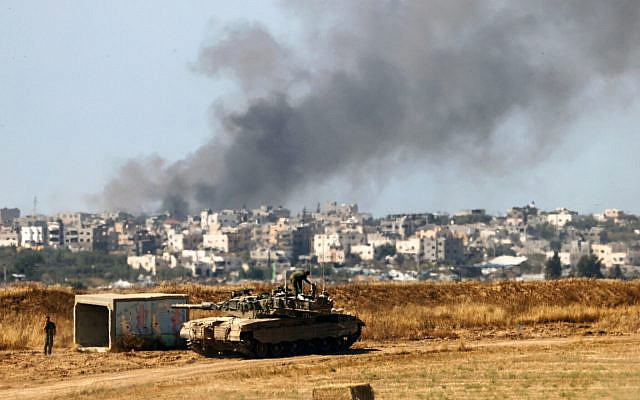Featured Post
10 necessary steps for the ‘day after’ in Gaza
They don't include a hostage deal 'at any price, or reestablish Gaza settlements, but they pave a way through this complex, dangerous situation

An Israeli tank is seen near the border with the Gaza Strip as smoke rises above the coastal enclave on May 15, 2024. (Jack Guez/ AFP)
The debate over the “day after” scenario for Gaza, once largely theoretical, is now bitterly and dangerously dividing Israel.
On one side of the controversy stands the security establishment — the IDF General Staff, the Shin Bet, and the Mossad — now led by Defense Minister Yoav Gallant. In the absence of a third party capable of governing post-war Gaza, they contend, the IDF will be saddled with both counterinsurgency duties and caring for 2.5 million Palestinians, many of them now destitute. The military gains of Operation Iron Swords will be frittered away and ultimately lost. The world, already exasperated with Israel, will isolate it completely.
The only solution, the security establishment says, is to transfer Gaza’s governance to the Ramallah-based Palestinian Authority (PA). Though far from ideal, a PA administration in Gaza is a lesser evil than military and diplomatic disaster.
Arrayed against the military echelon is the government, especially its more radical components, headed by Prime Minister Benjamin Netanyahu. “I will not let Hamastan become Fatahstan,” he pledged, referring to the Fatah party that dominates the PA. Ramallah, he recalled, never condemned the October 7 massacre nor ceased its efforts to delegitimize and criminalize Israel. The PA educates Palestinian children to kill Jews and pays salaries to convicted terrorists. Thoroughly corrupt and widely unpopular, the PA would quickly be ousted from Gaza by a resurgent Hamas, much as it was in 2007, Netanyahu predicts.
The sole solution, the prime minister concludes, is an indefinite Israeli military occupation of Gaza. Only by destroying every Hamas cell can Israel’s security be assured. Efforts will meanwhile continue to enlist non-Hamas elements in Gaza and the Abraham Accord states to cooperate in running and reconstructing the Strip. None of these efforts, it must be noted, have so far succeeded.
Between these two opposing camps are the hostage families demanding any arrangement, even an Israeli declaration of defeat, to attain their loved ones’ release. Right-wing activists meanwhile insist on reestablishing the Israeli settlements uprooted in the 2005 Disengagement from Gaza.
Finally, there is the United States, which is offering to organize an inter-Arab force to administer Gaza, spearhead a regional alliance against Iran, and broker a Saudi-Israel peace. In return, Israel must refrain from invading Rafah, permit a “revitalized” Palestinian Authority to assume civil control over Gaza, and agree to discuss a “pathway” to Palestinian statehood.
Confronted with such patently irreconcilable poisons, can a middle ground possibly be identified? Are there policies that Israel can adopt in Gaza that will, to the greatest extent possible, guarantee our security, preserve our gains in the war, and safeguard our relations with America and the world?
There are. Here are the 10 measures necessary to achieve Israel’s short and long-term goals in Gaza while meeting our critical diplomatic and strategic interests. Security and dignity can be attained for Israelis and Palestinians alike.
- Israel retains total security control in Gaza, including control of all borders and crossings, until Hamas is demonstrably defeated. Operations continue in Rafah and elsewhere following effective civilian evacuations. Military and diplomatic efforts to secure the hostages’ release continue unabated.
- Civil affairs, including health services and aid distribution, are administered by Gazans unaffiliated with Hamas. The model will be Area B of Judea and Samaria, where Israel is in charge of security and the Palestinians are responsible for the civil administration.
- The civil administration is supervised by the Palestinian Authority once it is “revitalized.” The PA first meets benchmarks for ending corruption and establishing transparent institutions. The designation and fulfillment of the benchmarks is carried out in coordination with Israel.
- The United States sends a greatly expanded and improved version of the Dayton Mission that trained PA police forces in Gaza after Israel’s disengagement.
- Abraham Accord countries launch a major inter-Arab initiative to rebuild and modernize Gaza.
- An international fund for developing Gaza’s economy is established.
- Israel enters discussions with the US on future peace initiatives. These include, but are not restricted to, a pathway to a two-state solution. Exploratory talks with Palestinian representatives may also begin.
- An Israeli-Saudi peace treaty is concluded.
- A NATO-like regional defense alliance against Iran is forged.
- Defense agreements guaranteeing the supply of vital US military supplies and intelligence to Israel during wartime are signed.
None of these measures is foolproof, risk free, or immune to criticism. They do not address the demands of those seeking a hostage deal at any price or the reestablishment of Gaza settlements. But the 10 steps do offer the best way forward through an unprecedentedly complex and dangerous situation. Implementing them requires vision, courage, and leadership.
Related Topics



